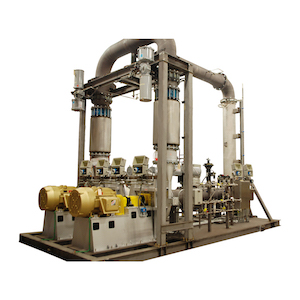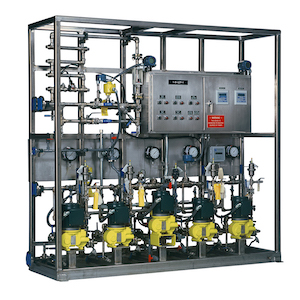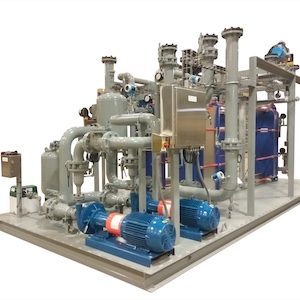The success of a modular process skid project begins with an understanding of how to specify process skids. The Carotek Process Skids Specification Guide outlines the advantages of custom process skids and how they can be specified.
Process Skid Costs can vary substantially depending on quality of components, welds and materials, as well as operating requirements. They can range from $25,000 to $3,000,000 and more, therefore each process skid must be estimated specifically for you.

Process Skid Advantages
When updating, expanding or scaling a manufacturing process, a custom process skid is generally a faster and more cost-efficient alternative to the traditional method of building process equipment and systems on site. The modularized approach of process skid design helps avoid logistical complications like on-site fabrication delays, long equipment lead times, scope responsibility and communication issues. They also help reduce the associated capital costs and time to production. Rather than being shipped in multiple shipments and installed incrementally on site, the process skid arrives at the facility fully assembled and tested. Larger skids arrive in modular sections ready to be connected on-site.
Process Skids Applications
Custom integrated process skids can be fabricated for nearly any application. These mechanical and electrical skid mounted process systems are pre-wired and mounted on a common base to meet facility specific design and process requirements. Types of process skids include fuel transfer and demineralized water process skids, chemical process skids, and custom process skids for applications ranging from truck unloading skids to reactor skids, distillation process skids and simple pump and blower skid packages.

Specifying Process Skids Requirements
When designing a process skid, often best to focus on performance rather than specifying components (unless it’s necessary to specify brands and components to ensure integration with existing products). Otherwise, detailed components specifications may be time consuming and could introduce process inefficiencies. The most vital component of a process skid specification is the P&ID (piping and instrument diagram) outlining the components including pumps, tanks, reactors and columns, valves, instruments and electrical control panel requirements. A proper P&ID will include flows rates and pressures, temperatures, line sizes and components mentioned above.
Performance requirements for a process skid may include specifications like:
- materials of construction ie; stainless steel, 316, 304, carbon steel, higher grade alloys
- process flow rates and pressures
- pipe line sizes
- symbol chart for components
- environmental, power, facility, safety, and dimensional requirements
- user interface requirements (HMI’s)
- Ethernet protocol that must be complied with
- electrical performance requirements including electrical connection, disconnect, control wiring, sensor types, enclosure rating (e.g., NEMA 12), labeling for wiring and hoses, and minimum/maximum operating temperature
- design requirements like locations of pipe outlets and inlet on one side of the skid, and valves accessible from one side of the skid
- ongoing support required
Often a general “scope of supply” is included in the P&ID signifying the scope boundary for the process skid vendor. Many companies requesting a process sid design will supply a general outline of the purpose of the skid and how it may integrate into other processes in the manufacturing process.
Process Skids Supplier Selection
Partnering with a process skid fabricator offers the advantage of building and testing process equipment off site. Any site facility upgrades that are needed can be scheduled in parallel to process equipment fabrication. When selecting a supplier for process skid fabrication, several criteria are important to ensure success of the project.

- Expertise – Does the process skid fabricator offer standard customizable process skids for your application? What expertise do they have with your industry, equipment, and process? For example, an understanding of industry piping standards can speed up the process skid design phase. Fabrication of process skids, chemical process skids, and other custom process skids all benefit from specialized knowledge of the industry.
- Services – Does the fabricator offer a full range of services, including concept development, process systems design, controls engineering, fabrication and assembly, testing, installation, startup, and commissioning?
- Facility – Is the facility designed with ample space for fabrication and testing? Indoor space ensures that weather delays are not a factor and should provide an ideal environment for welding and fabrication.
- Certifications – Can they obtain required certifications? Understanding of code requirements and certifications for certain specific codes like ASME, UL and hazardous duty areas are important.
- Testing – How will the process skid be tested before shipment? FAT (factory acceptance test) reduces risk by eliminating start-up problems and reduces the timeline to production. During fabrication NDE (non-destructive testing) capabilities are often required for piping and vessel fabrication. Be sure to understand what NDE test are required and that the vendor has those capabilities.
Engaging with your selected vendor early in the planning phase of the project allows for the greatest budget and timeline gains and reduces overall project risk. Give your process skid vendor ample time to produce a quote that is meets the specifications you have written for a process skid. This will eliminate missed specifications and requirements that can become problematic later in the fabrication and installation process.
For more specifics by skid type, visit:
As a world renowned fabricator of custom integrated process skids, Carotek creates mechanical and electrical skid mounted process systems that are pre-wired and mounted on a common base to meet your specific design and process requirements. Carotek can supply most major components including pumps, valves, instrumentation, piping, control panels, seal pots and more - making Carotek your single source solution for custom integrated process skid packages.



